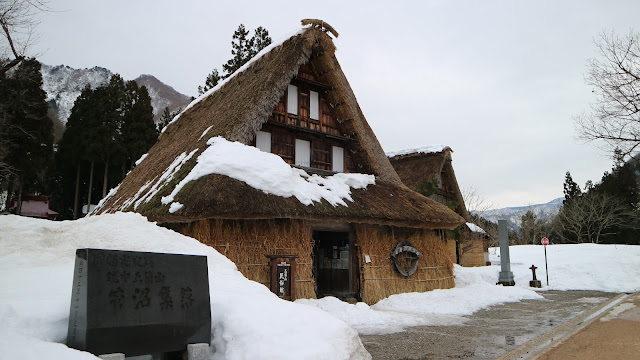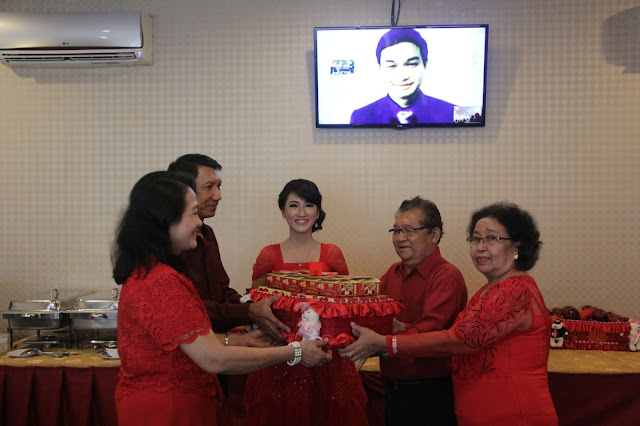Half Day in Gokayama: Sightseeing in Suganuma and Making Washi Paper
On January 20th, 2018, we joined a bus tour held by Toyama International Junction (TIJ) to go to Gokayama, an area in Nanto City, Toyama Prefecture.
TIJ team arranged the tour for international students (and also the international citizens) that live in Toyama City.
So, here was our schedule:
Sightseeing in Suganuma Village
As written in the agenda, our first stop was in Suganuma Village.
Actually, Gokayama has 3 villages that registered as UNESCO World Heritage List, those are Suganuma, Ainokura, and Ogimachi.
But we only went to Suganuma Village because it was the first village we could reach from Toyama City.
All villages have this Gassho-zukuri houses that made them special as the world heritage.
Gassho-zukuri or Gassho-style means the form of praying hands.
It represents roof of the farmhouses that two sides of the roof are joined together.
This is a part of minka architecture, which applied in houses of farmers, artisans, and merchants in Japan.
Minka-style architecture is characterized by the basic structure, roof structure, and also roof shape. That's why we can notice it in the roof shape of Gassho-zukuri houses.
Most of the houses here had already changed to souvenir shops or restaurants.
If you plan to come here, make sure you buy unique design of the souvenirs and try the restaurants.
They made fluffy vegetables souvenirs as the symbol of their harvest.
In this village, there are Gokayama Folklore Museum and Saltpeter Museum.
Because the time was short, we only entered the Saltpeter Museum.
It's cheaper if we choose both. But, this was also nice.
This museum exhibits the making process of saltpeter (potassium nitrate), which is the principal ingredient in gunpowder.
In the entrance, there was model of a man making the saltpeter.
Unfortunately, we weren't allowed to take pictures inside the museum. But this was worth to visit.
In the exit door, there was an area that we could try to use the gun.
It is connected with an infrared and if we pulled the trigger, it would sound like we were in a war field.
After enjoy the museum and sightseeing in the village, we went back to the bus to continue the schedule.
Oh, by the way, we saw this gorgeous cliff when we came to this village.
Making Ecchu Washi Paper
Ecchu washi paper or simply called washi paper is well-known as the Japanese traditional craft from Gokayama.
In this opportunity, we had chance to make the paper by ourselves in a home industry.
They also sold a lot of souvenirs made by this washi paper.
Shortly to make the paper, we started with a designated wooden mold that was dipped into chemical water. We should gently slide the mold to left and right then up and down, so it could form a thin layer of paper.
Next, we moved the mold to a table so we could open the mold and only left a wooden (or bamboo, I guess) slab the washi paper's base. And we gently pour water above it, so it could be separated from the slab.
After the paper was separated, we did some decoration from leaves that they had provided for us.
When the decoration had finished, our papers were brought to a large hot slab to be dried.
The day we went to Gokayama was my 27th birthday.
So, we decorated the paper with combination of number 2 and 7, then we put two papers together became number 27.
P.S.: We only allowed to put 3 leaves for the decoration.
Can't wait to have another experience on my birthday next year.
Thank you for my lovely husband!
References:
1. Gokayama: Gassho-style Architecture
2. NAVITIME: Shirakawa-go's Gassho-zukuri Style Architecture
3. Wikipedia: Minka
4. Tabi Nanto: Japanese Paper "Washi" Making (Gokayama Washi no Sato)
5. JTCO: Japanese Traditional Craft-Gokayama Washi Paper
6. Japan Hopper: Ensho-no-Yakata Museum
We were so lucky because to join the tour, we only need to pay ¥500 per person.
If we go there by public bus, we need to pay ¥860 to ¥1,200 for 30 to 80 minutes trip, depends on the route we choose. For detail, read this site.
 |
| | Gassho-zukuri House in Gokayama | |
TIJ team arranged the tour for international students (and also the international citizens) that live in Toyama City.
So, here was our schedule:
- There were 18 of us that take around 60 minutes of trip and observed the Suganuma Village, one of the village in Gokayama that has the famous farmhouses named Gassho-zukuri.
- After enjoy the sightseeing in Suganuma Village, we went to a home-industry to learn how to make Gokayama washi paper (widely known as Ecchu washi), the traditional paper that is designated as one of Japan's traditional craft product.
- Then at the end of the trip, we went back to Toyama International Junction sharing the idea of next trip for international people in Toyama.
Sightseeing in Suganuma Village
As written in the agenda, our first stop was in Suganuma Village.
Actually, Gokayama has 3 villages that registered as UNESCO World Heritage List, those are Suganuma, Ainokura, and Ogimachi.
But we only went to Suganuma Village because it was the first village we could reach from Toyama City.
All villages have this Gassho-zukuri houses that made them special as the world heritage.
Gassho-zukuri or Gassho-style means the form of praying hands.
It represents roof of the farmhouses that two sides of the roof are joined together.
This is a part of minka architecture, which applied in houses of farmers, artisans, and merchants in Japan.
Minka-style architecture is characterized by the basic structure, roof structure, and also roof shape. That's why we can notice it in the roof shape of Gassho-zukuri houses.
 |
| | Gassho-zukuri Souvenir Shop | |
Most of the houses here had already changed to souvenir shops or restaurants.
If you plan to come here, make sure you buy unique design of the souvenirs and try the restaurants.
They made fluffy vegetables souvenirs as the symbol of their harvest.
 |
| | Miniature of Gassho-zukuri House | |
 |
| | Souvenirs from Gokayama | |
In this village, there are Gokayama Folklore Museum and Saltpeter Museum.
Because the time was short, we only entered the Saltpeter Museum.
It's cheaper if we choose both. But, this was also nice.
 |
| | Ticket Box of Saltpeter Museum | |
 |
| | Price List of the Entrance Fee | |
This museum exhibits the making process of saltpeter (potassium nitrate), which is the principal ingredient in gunpowder.
In the entrance, there was model of a man making the saltpeter.
Unfortunately, we weren't allowed to take pictures inside the museum. But this was worth to visit.
 |
| | Model of A Man Making Saltpeter | |
In the exit door, there was an area that we could try to use the gun.
It is connected with an infrared and if we pulled the trigger, it would sound like we were in a war field.
 |
| | Bayu Tried the Gun | |
 |
| | Ricca Tried the Gun | |
After enjoy the museum and sightseeing in the village, we went back to the bus to continue the schedule.
Oh, by the way, we saw this gorgeous cliff when we came to this village.
 |
| | Cliff in Suganuma Village | |
Ecchu washi paper or simply called washi paper is well-known as the Japanese traditional craft from Gokayama.
In this opportunity, we had chance to make the paper by ourselves in a home industry.
They also sold a lot of souvenirs made by this washi paper.
 |
| | Washi Paper's Souvenir Shop and Home Industry in Gokayama | |
 |
| | Outside View of the Shop | |
 |
| | Entrance of Washi Paper's Shop | |
 |
| | Price Information of Washi Paper Making | |
Shortly to make the paper, we started with a designated wooden mold that was dipped into chemical water. We should gently slide the mold to left and right then up and down, so it could form a thin layer of paper.
 |
| | Moving the mold to make layer of Washi paper | |
Next, we moved the mold to a table so we could open the mold and only left a wooden (or bamboo, I guess) slab the washi paper's base. And we gently pour water above it, so it could be separated from the slab.
 |
| | Our friend, Irene, was separating the paper from the slab | |
After the paper was separated, we did some decoration from leaves that they had provided for us.
When the decoration had finished, our papers were brought to a large hot slab to be dried.
 |
| | Our friend, Sisca, was decorating the paper | |
 |
| | Washi Papers were being dried in hot slab | |
They also made colored washi paper like this picture below.
 |
| | Another Process of Making Colored Washi Paper | |
So, that was the end of our Washi Paper making.
We brought our washi paper and we could add it into our home decoration.
After all of that schedule, we went back to Toyama, to gather in Toyama International Junction and sharing some plan for future agenda.
However we didn't take any picture of it.
That was nice to know the people who in charge on this trip and we added more new friends.
As the closing of this post, enjoy this pictures of Gokayama in Winter.
Winter in Gokayama
 |
| | A Street in Gokayama | |
 |
| | Village under the Mountain | |
 |
| | Village in Gokayama | |
 |
| | River and Houses under the Mountain | |
The day we went to Gokayama was my 27th birthday.
So, we decorated the paper with combination of number 2 and 7, then we put two papers together became number 27.
P.S.: We only allowed to put 3 leaves for the decoration.
 |
| | Result of Our Washi Paper | |
Can't wait to have another experience on my birthday next year.
Thank you for my lovely husband!
 |
| | In Front of A Gassho-zukuri House | |
References:
1. Gokayama: Gassho-style Architecture
2. NAVITIME: Shirakawa-go's Gassho-zukuri Style Architecture
3. Wikipedia: Minka
4. Tabi Nanto: Japanese Paper "Washi" Making (Gokayama Washi no Sato)
5. JTCO: Japanese Traditional Craft-Gokayama Washi Paper
6. Japan Hopper: Ensho-no-Yakata Museum










Comments
Post a Comment